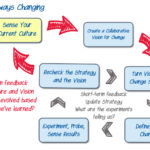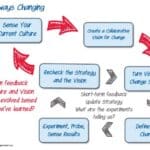We’ve seen the risks of assuming that everything is normal distribution, and also the problem with reporting a single number. What else do we need to be aware of? What can we usefully measure? Risks in Measurement Many important things can’t be measured using formal measurement systems. As a result, not enough attention is paid […]
Scrum Team
Forecasting, Metrics and the Lies that a Single Number Tell Us
This post has now been replaced by the updated and expanded Red-Yellow-Green Status Reports and Other Models – How They Should and Shouldn’t Be Used post. Please update all bookmarks and links accordingly. We’ve previously seen that our mental models often make false assumptions due to cognitive bias. Giving a Single number in a report has […]
Agile Change or Adoption: Turn Vision into Strategy
(Continued from Agile Change or Adoption Always Starts with Why : 1 , 2 , 3 , 4 ) We’re already familiar with how Story Maps are an excellent way to help development teams visualize the work involved in building a large product. They act as stepping-stones between the initial vision and the resulting deliverable user stories. But Story Maps can serve a similar purpose […]
Agile Change or Adoption: Create a Vision
(Continued from Agile Change or Adoption Always Starts with Why: Part 1, Part 2, Part 3) Most organizational change effort starts with a vision. But problems arise if the vision was created by a few executives who went off-site, as that can result in a vision that doesn’t address the problems felt by the doers at […]
Agile Change or Adoption: Sense Your Current Culture
(Continued from Agile Change or Adoption Always Starts with Why: Part 1, Part 2) Sense Your Current Culture To understand the culture you’re attempting to change in your organization, you need to measure (or sense) the current state and then map that state to a model. The model we will use is the Schneider Culture Model.[1] [2] […]
Agile Change or Adoption: the Steps to Go from “Why” to “How”
(Continued from Agile Change or Adoption Always Starts with Why) If you’re going to become an Agile Organization, and you understand that it has to be a collaborative discussion and effort rather than an executive decree, here are the key ingredients to move forward with that decision effectively: Sense Your Current Culture Be mindful of the […]
Agile Change or Adoption Always Starts with Why
Your organization has decided to become more “Agile.” Why? As we learned in a previous blog post, “Because Our Competitors Are” is not a valid – or sensible – reason. Before embarking on a change, adoption, or improvement program, you need to know the rationale behind that decision. So… why Agile? A traditional approach to […]
Bell Curves and Measuring Badly
False Assumptions and Cognitive Biases To keep life manageable, and so we don’t run out of steam before we leave the house in the morning, we develop a series of mental shortcuts, aka habits. Habits aren’t only things like brushing our teeth and locking the front door, but also include our route to work and […]




